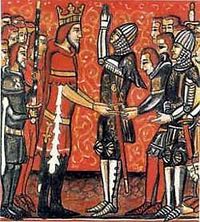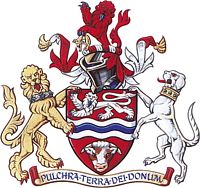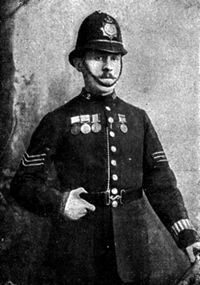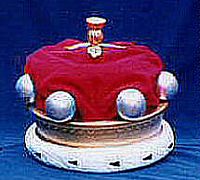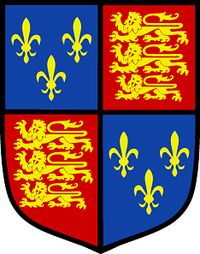|
Title: | Economics and Politics: Government in Ewyas Lacy |
|
The forms of government in Ewyas Lacy have been divided for convenience below into 'feudal' until the late middle ages, and 'modern' from the 16th/17th century onwards. No such clear-cut transition exists in history; the process of change was evolutionary and in the main gradual, but it is hoped that the artificial disitinction will make browsing this part of the website for relevant topics easier. The roles of officials and other prominent people involved in various aspects of the governance of Ewyas Lacy also changed, sometimes radically, over the centuries and researchers should bear this in mind when browsing in those particular subject areas below. The links on this page reflect most aspects of governance having significant numbers of references in the website records, but are not exhaustive; please use the site search engine to explore other possibilities.
|
Feudal Government
Common features of feudal societies include an overwhelmingly agrarian economy with limited money exchange, a powerful ruling class with absolute control over the administration of the law, and a church with strong moral authority acting as an ally of the ruling classes and taking a share of the wealth and land. In Norman and medieval England these conditions certainly existed, and it has been said that there were only 'three orders' of society - those who made war, those who prayed and those [the vast majority] who laboured.
The reality, however, was much more complex. Even before the Normans arrived, Anglo-Saxon England had a sophisticated form of government divided into 'shires' as administrative and tax-raising units, run by officials called 'shire-reeve' or sheriff under the King and his nobles. Many of the English shires had also been divided since Saxon times into 'Hundreds' for administrative, judicial and military purposes, headed by prominent local families. The Normans took over and centralised this system, re-naming the shires as 'counties' while displacing the native aristocracy and taking power into their own hands through a manorial system of land holdings granted by the King to noblemen who had sworn fealty.
| |
To browse references to aspects of feudal government in Ewyas Lacy, follow the links below. |
| |
| Modern Government
By the 17th century the traditional feudal hierarchies had largely lost their power and the system of Manorial courts providing local governance through the Lord of the Manor was beginning to break down, although it was not finally extinguished until the establishment of County Courts in 1867. The Hundreds became less relevant too, as their functions were gradually replaced by the developing role of civil parishes, townships and specialised sub-divisions of counties such as poor law unions and highway districts. The transition to civil parishes in their modern sense, with elected councils, grouped into Rural Districts under the auspices of County Councils, was completed with the Local Government Act 1894, which followed the 1889 introduction of administrative Counties and County Boroughs and swept away the last of the old order. Reforms continued in the 20th century, particularly in diminishing the role of the civil parish, but the basic settlement of 1894 persists to the present day.
| |
To browse references to aspects of modern government in Ewyas Lacy, follow the links below. |
| |
| | Officials
The titles of many of the officials who played a part in governing Ewyas Lacy have ancient origins, though past roles were often quite different from modern usage. Thus the title of bailiff originally applied to the chief officer of a Hundred who exercised authority in his 'bailiwick', while under the manorial system the bailiff's role was reduced to superintending the cultivation of the manor. A clerk was a cleric or scholar in medieval times, when few could read or write. The office of constable was introduced by the Normans for the keeping and maintenance of the king's armaments locally, before evolving to keeping general order. Coroners were created in the 11th century to protect the financial and other interests of the crown in local court cases before gradually becoming more specialised. Escheators served a similar powerful function in protecting the king's interests in land, ownership of which had been vested in the crown since Norman times, until changing concepts of land ownership and tenancy eventually made the role redundant. Stewards, originally appointees of the king to govern in his absence, came to act for the absentee Lords of the Manor in the manorial courts and later became simply estate managers. Other similar examples of change can readily be found.
|
To browse references to officials in Ewyas Lacy, follow the links below. |
| |
| | Prominent People
Throughout recorded history great importance has been attached to social status, reflected through a hierarchy of titles by which people styled themselves. For many centuries these titles were also often accompanied by direct military or political power. There is a fixed order of precedence in the peerage below the king, continuing into the minor aristocracy or 'landed gentry' with knighthoods and baronetcies and then to vaguer honorifics where esquires in the upper gentry were distingished from 'gentlemen', who in turn ranked above yeomen. In this hierarchy, the title 'Lord of the Manor' is an interesting exception, having been held in Ewyas Lacy by individuals of amost every rank [including the king] at one time or another.
|
To browse references to the titles of prominent people in Ewyas Lacy, follow the links below. |
| |
 | De Lacy Family history
Background and genealogy of the branch of the Norman de Lacy family that held Ewyas Lacy from c.1067 until 1241
|
| |
| |

